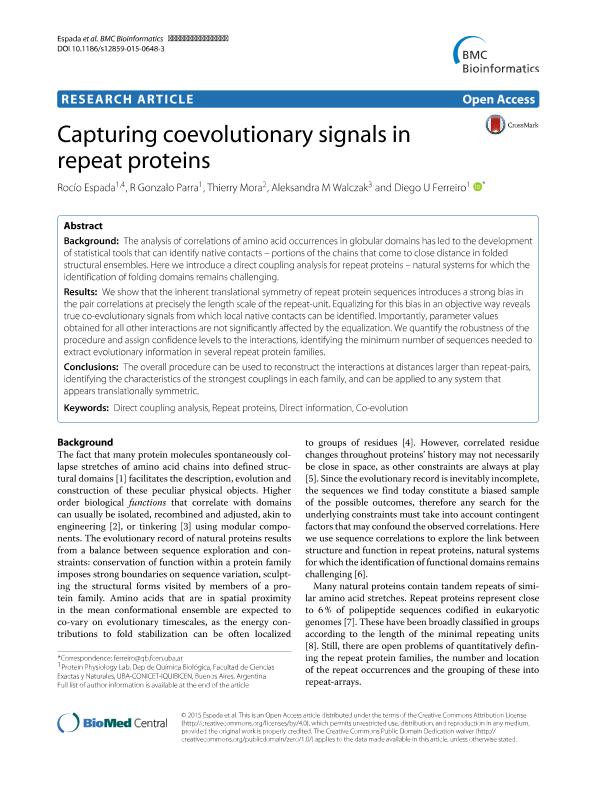Artículo
Capturing coevolutionary signals inrepeat proteins
Fecha de publicación:
12/2015
Editorial:
BioMed Central
Revista:
BMC Bioinformatics
ISSN:
1471-2105
Idioma:
Inglés
Tipo de recurso:
Artículo publicado
Clasificación temática:
Resumen
Background: The analysis of correlations of amino acid occurrences in globular domains has led to the development of statistical tools that can identify native contacts - portions of the chains that come to close distance in folded structural ensembles. Here we introduce a direct coupling analysis for repeat proteins - natural systems for which the identification of folding domains remains challenging. Results: We show that the inherent translational symmetry of repeat protein sequences introduces a strong bias in the pair correlations at precisely the length scale of the repeat-unit. Equalizing for this bias in an objective way reveals true co-evolutionary signals from which local native contacts can be identified. Importantly, parameter values obtained for all other interactions are not significantly affected by the equalization. We quantify the robustness of the procedure and assign confidence levels to the interactions, identifying the minimum number of sequences needed to extract evolutionary information in several repeat protein families. Conclusions: The overall procedure can be used to reconstruct the interactions at distances larger than repeat-pairs, identifying the characteristics of the strongest couplings in each family, and can be applied to any system that appears translationally symmetric.
Palabras clave:
Co-Evolution
,
Direct Coupling Analysis
,
Direct Information
,
Repeat Proteins
Archivos asociados
Licencia
Identificadores
Colecciones
Articulos(IQUIBICEN)
Articulos de INSTITUTO DE QUIMICA BIOLOGICA DE LA FACULTAD DE CS. EXACTAS Y NATURALES
Articulos de INSTITUTO DE QUIMICA BIOLOGICA DE LA FACULTAD DE CS. EXACTAS Y NATURALES
Citación
Espada, Rocío; Parra, Rodrigo Gonzalo; Mora, Thierry; Walczak, Aleksandra M.; Ferreiro, Diego; Capturing coevolutionary signals inrepeat proteins; BioMed Central; BMC Bioinformatics; 16; 1; 12-2015; 207-217
Compartir
Altmétricas




